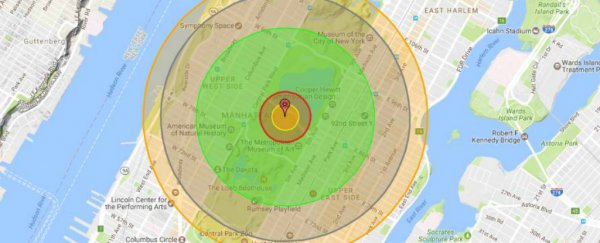It's been more than 70 years since two nuclear bombs were detonated over the Japanese cities of Hiroshima and Nagasaki, killing at least 129,000 people, and causing devastating, long-term health effects.
To date, those are the only instances of nuclear weapons being used for warfare, but the reality is there are almost 15,000 nuclear warheads remaining in the world today – and many of them are substantially bigger than the ones used during WWII. So, what would happen if nuclear war broke out tomorrow?
Don't panic – there's no evidence nuclear war is on the horizon. But in the video below, the team from AsapSCIENCE breaks down the science of nuclear bombs to predict how likely you'd be to survive. Let's just say, in the case of a nuclear blast, you would want to be wearing white.
First, let's get this out of the way - there is no clear-cut impact of a single nuclear bomb, because it depends on a whole lot of things, including the weather on the day it's dropped, the time of day it's detonated, the geographical layout of where it hits, and whether it explodes on the ground or in the air.
But generally speaking, there are some predictable stages of a nuclear bomb blast.
As the video above explains, approximately 35 percent of the energy of a nuclear blast is released in the form of thermal radiation. And seeing as thermal radiation travels at approximately the speed of light, the first thing that will hit you is a flash of blinding light and heat.
The light itself is enough to cause something called flash blindness – a temporary form of blindness that can last a few minutes.
The AsapSCIENCE video considers a 1 megaton bomb, which is 80 times larger than the bomb detonated over Hiroshima, but much smaller than many modern nuclear weapons (more on that later).
For a bomb that size, people up to 21 km (13 miles) away would experience flash blindness on a clear day, and people up to 85 km (52.8 miles) away would be temporarily blinded on a clear night.
Heat is an issue for those closer to the blast. Mild, first-degree burns can occur up to 11 km (6.8 miles) away, and third-degree burns – the kind that destroy and blister skin tissue – could affect anyone up to 8 km (5 miles) away.
Third-degree burns that cover more than 24 percent of the body will likely be fatal if people don't receive medical care immediately.
Those distances are variable, depending not just on the weather, but also on what you're wearing - white clothes can reflect some of the energy of a blast, while darker clothes will absorb it.
That's unlikely to make much difference for those unfortunate enough to be at the center of the explosion, though.
The temperatures near the site of the bomb blast during the Hiroshima explosion were estimated to be 300,000 degrees Celsius (540,000 degrees Fahrenheit) - which is 300 times hotter than the temperature bodies are cremated at, so humans were almost instantly reduced to their most basic minerals.
But for those slightly further away from the center of the blast, that's not what's most likely to kill you.
As the video above explains, most of the energy released in a nuclear explosion is in the blast, which drives air away from the site of the explosion, creating sudden changes in air pressure that can crush objects and knock down buildings.
Within a 6-km (3.7-mile) radius of a 1-megaton bomb, blast waves will produce 180 tonnes of force on the walls of all two-story buildings, and wind speeds of 255 km/h (158 mph).
In a 1-km (0.6-mile) radius, the peak pressure is four times that amount, and wind speeds can reach 756 km/h (470 mph).
Technically, humans can withstand that much pressure, but most people would be killed by falling buildings.
If you somehow survive all of that, there's still the radiation poisoning to deal with – and the nuclear fallout.
We'll let AsapSCIENCE explain that in the video above, but the ongoing effects on the planet of that fallout are longer-lasting than you might expect.
Again, all of this is hypothetical, there are international treaties in place to stop the spread of nuclear weapons, so we hope you never need to know any of this information for real.
But before we let you go, we should touch on the fact that 1 megaton bombs are barely the standard these days – the largest nuclear weapon ever tested is the 50 megaton Tsar bomb that was dropped on an isolated island in Russia, and released roughly the energy of 3,333 Hiroshima bombs combined.
If you want to put that in perspective, check out the anxiety-inducing video below:
